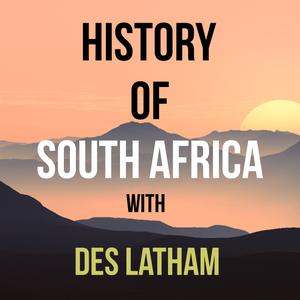Episode 202 - America’s Constitutional link to Boer Republics and a Cave Looms large
This is episode 202, the sounds you hear are the sounds made by wagons rolling across the veld — because we’re going to join the trekkers who’ve mostly stopped trekking.
For the trekkers, the promised land was at hand. The high veld, parts of Marico, the northern Limpopo region, the Waterberg, the slopes of the Witwatersrand into the lowveld, the Free State with its rocky outcrops and vastness, the dusty transOrangia.
In the Caledon Valley, Moshoeshoe was monitoring the Dutch speakers who were now speaking a combination of languages, morphing the taal into Afrikaans.
Further east, King Mpande kaSenzangakona of the Zulu had been keeping an eye on the colonial developments while indulging in expansion policies of his own. This period, 1854 and 1855, is like a fulcrum between epochs. The previous lifestyle of southern Africa, pastoral and rural, was running its final course, the final decade before precious mineral discoveries were going to change everything.
Let’s just stand back for a moment to observe the world, before we plunge back into the going’s on in the Boer Republics. Momentous events had shaken Europe, a succession of revolutions which had somehow swept around Britain but never swept Britain away.
This is more prescient than it appears. These revolutions are forgotten now, they’re an echo but in the echo we hear the future. The 1848-1855 revolutions were precipitated by problems of imperial overload in Europe.
Liberal nationalism was also sweeping the world, and the American constitution was on everyone’s lips.
Copies of the American Constitution were cropping up in the oddest places. Like the back of Boer ox wagons and inside the churches, alongside the Bibles. American missionary Daniel Lindley who you heard about in our earlier episodes, the man from Ohio who had started out life in south Africa as a missionary based near Mzilikazi of the amaNdebele’s great place near Marico. He had copies distributed to the Boers.
This is important. There is a direct link between the American constitution, South African concepts of what democratic rights were, which you could then track all the way to the 1994 New Constitution after apartheid.
Schoemansdal, to the north, and the basis of ivory trade, was much bigger and richer than Potch. The Schoemansdalers looked down their noses at the Potchefstroomers — it was an ancient Biblical pose — it was hunters and shepherds versus farmers, Cain versus Abel. The clash between settled and nomadic societies.
One of the dirty little secrets of South African life in the mid-19th Century was how successfully these new arrivals in the north, the trekkers, had decimated the elephant, rhino, lion, leopard, crocodile, and hippo populations. Schoemansdal was living on borrowed time.
The story begins with a hunting party seeking white gold — ivory. An elephant hunt.
It also begins with a massacre, and ends with a siege of a cave.
The Nyl Rivier was always disputed territory, particularly since chief Makapan and Mankopane, otherwise known as Mapela - Nyl means Nile and the Boers had renamed this river for all sorts of important resonant reasons. This river is a tributary of the Limpopo and it is located in the northern part of the Springbok flats.There are two main versions of what happened, and I’m going to relate both, then we shall try to extricate fact from fiction. This episode will deal with the initial events, and next episode we shall conclude the saga with it’s terrifying cave fighting and ultimate South African symbolism.
The Langa and Kekana people first experienced trekkers in 1837 when Louis Trichardt entered their territory — from then on a steady trickle of trekkers could be found inside Langa and Kekana territory. The area we’re focusing on is close to where the town of Potgietersrus would be founded, the modern day town of Mokopane.
We can begin to connect our histories here. Makapan, Mokopane, Mankopane, Potgieter.
22 December 2024, 7:26 am
